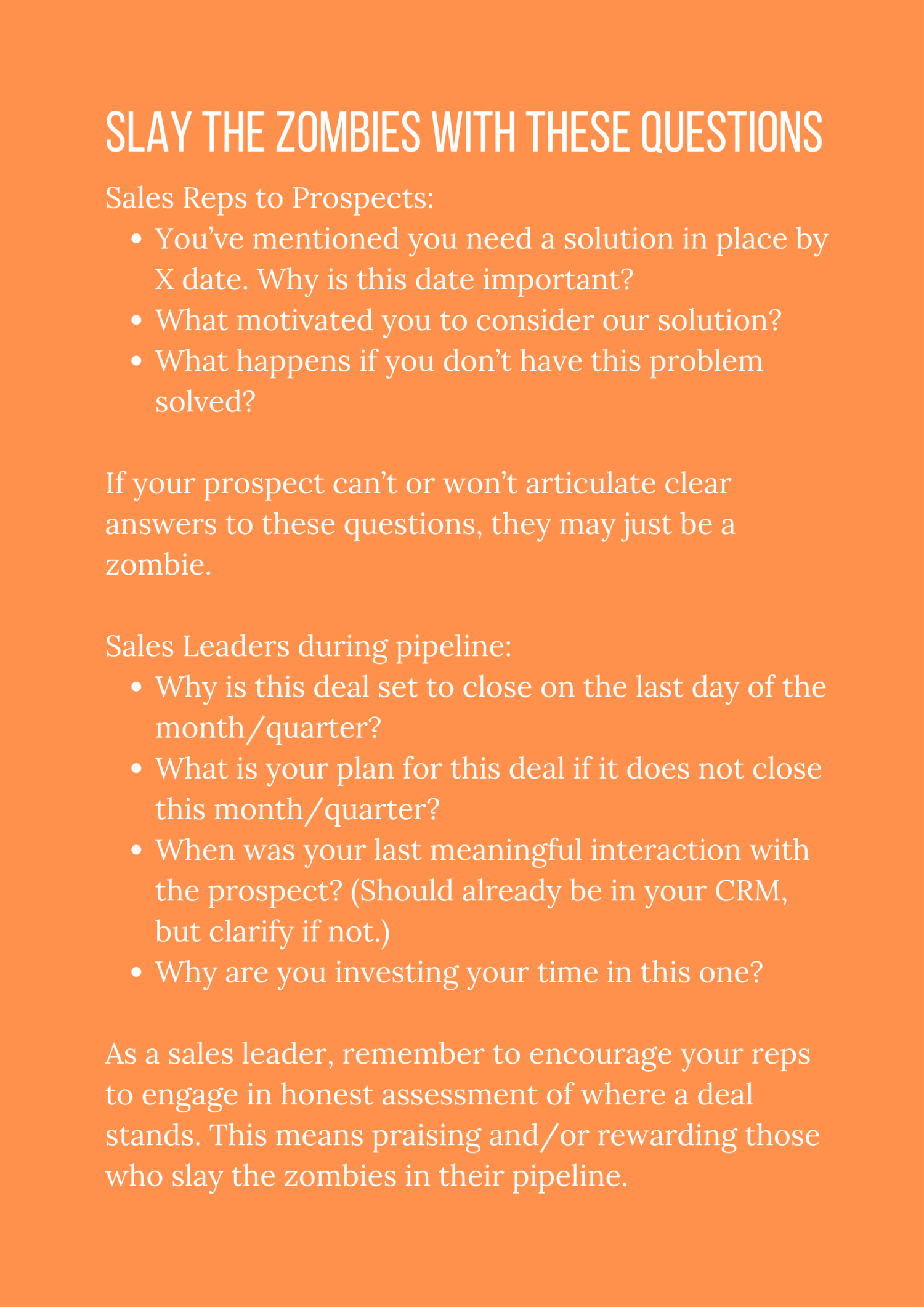Why are you keeping prospects in your CRM when you know the deal is dead?
October 06, 2021
By Mike Valade
You just wrapped up Q3 and you’re “champing at the bit”—Billions fans unite—to close your first deal of Q4. Maybe you killed it this quarter. Maybe things didn’t work out as well as you would have liked. Chances are, if you didn’t hit your number this quarter, you are carrying some deals into the new quarter that, if you’re being truly honest with yourself, will never close. Even those of you meeting or exceeding your quota would likely benefit from a scrub of your pipeline to drive a stake in these “walkers” wandering about (or if you’re older, resist the evil of the Thriller).
Why are you keeping those deals in your pipeline? Well, lots of different reasons of course, but if you want to sell more faster, ferociously guard against this all-too-common pitfall. That prospect with whom you had such a great first discovery call but hasn’t returned an email or a call since? Not going to close. The whale that will put you in President’s Club if it will just come in but hasn’t been heard from since the time of Captain Ahab? Burning up your bandwidth.
Writing in the context of innovation and zombie projects, the Harvard Business Review (HBR) defined the walking dead as those projects—or deals in the sales context—that “fail to fulfill their promise and yet keep shuffling along, sucking up resources without any real hope of having a meaningful impact on the company’s strategy or revenue prospects.” Here at Maestro, we see a direct analogy between zombies as innovation slayers and as pipeline pluggers.
Hopefully we can all agree that allocating resources to deals with little to no chance of closing is counterproductive. But how did these deals get in the pipeline in the first place? HBR points out that they all make sense at first. Forecasting seems reasonable, assumptions are plausible, and the timeline appears achievable.
In the context of sales, what happens next is a variation on the theme of the DRIVE information-gathering framework. The decision maker has gone dark. They’re working on securing budget. Your solution is a nice-to-have, not a need. The status quo might be good enough for now. We forget the prospect’s expectation that we will understand and address WIIFM (what’s in it for me) instead of “just following up.”
As individual contributors, we can avoid the zombie apocalypse through effective discovery, delivering value rather than selling features, and ultimately, honest assessment rather than wishful thinking. Sales leaders must reward the behavior they seek. If you exclusively focus on metrics such as the dollar amount in your rep’s pipeline or the number of deals in a given stage (both important metrics to be sure) without a critical eye for deals withering on the vine, you will only encourage your team to float that deal another week, which quickly turns into a month and then a quarter with no tangible progress.
Don’t fall prey to confirmation bias—playing up the good news and ignoring the bad as the deal slides another week. As a sales leader, it is incumbent upon you to praise and reward your reps who realistically assess a deal’s status and cut loose the dead weight—even if that means more closed lost deals. Moving on from a zombie just opens up more bandwidth for your team to move deals through the funnel that have a real chance of becoming a closed won deal. Therefore, getting these deals out of your pipeline should be viewed as a successful outcome.
Spend any time in sales and you will see the following vignette play out. Reps set the close date for a deal in the CRM for the end of the month, and then the end of the quarter, and then, when the deal has not closed at the end of the quarter, the rep rolls the deal over to the next quarter. This is the quintessential zombie gestation, leading to wasted resources and missed quotas. These deals tend to be those with limited or no touch points between actual meetings and long lags in responses to emails.
Sales representatives should watch out for and recognize when a deal that started out in a promising way starts to exhibit these symptoms. Then take your own action to either remedy the problem or, barring a quick shift, move it to close lost. As a sales leader, review the CRM records in advance of your pipeline meeting with an eye toward touch-point frequency, prospect response time, and stage progression. Look for deals with close dates equal to the end of the month or quarter that lack the call/meeting notes supporting that close date based on statements from the prospect. If/when those deals push to the next month/quarter, that should be a red flag for you as a sales leader that you may have a zombie in your midst.
Apply rigor to your deals and your pipeline as a whole. Avoid the temptation to float that large deal—chasing a prospect who is unresponsive for weeks or months—just to inflate the dollar amount shown in the CRM.
Zombies feast on the deals that are actually alive.
No matter where you sit in the (likely virtual) sales room, zombies in your pipeline are eating away your most valuable commodity—your time. Your quota, your team’s sales forecast, and ultimately your company’s revenue depend on your ability to slay the zombies. Don’t let the walking dead feast on the deals that are actually alive in your pipeline and can turn into a closed won deal.

Want your sales team to slay the walking dead and sell more, faster? Reach out to our zombie slayers at mastery@maestrogroup.co.
Get the Maestro Mastery Blog, straight to your inbox.